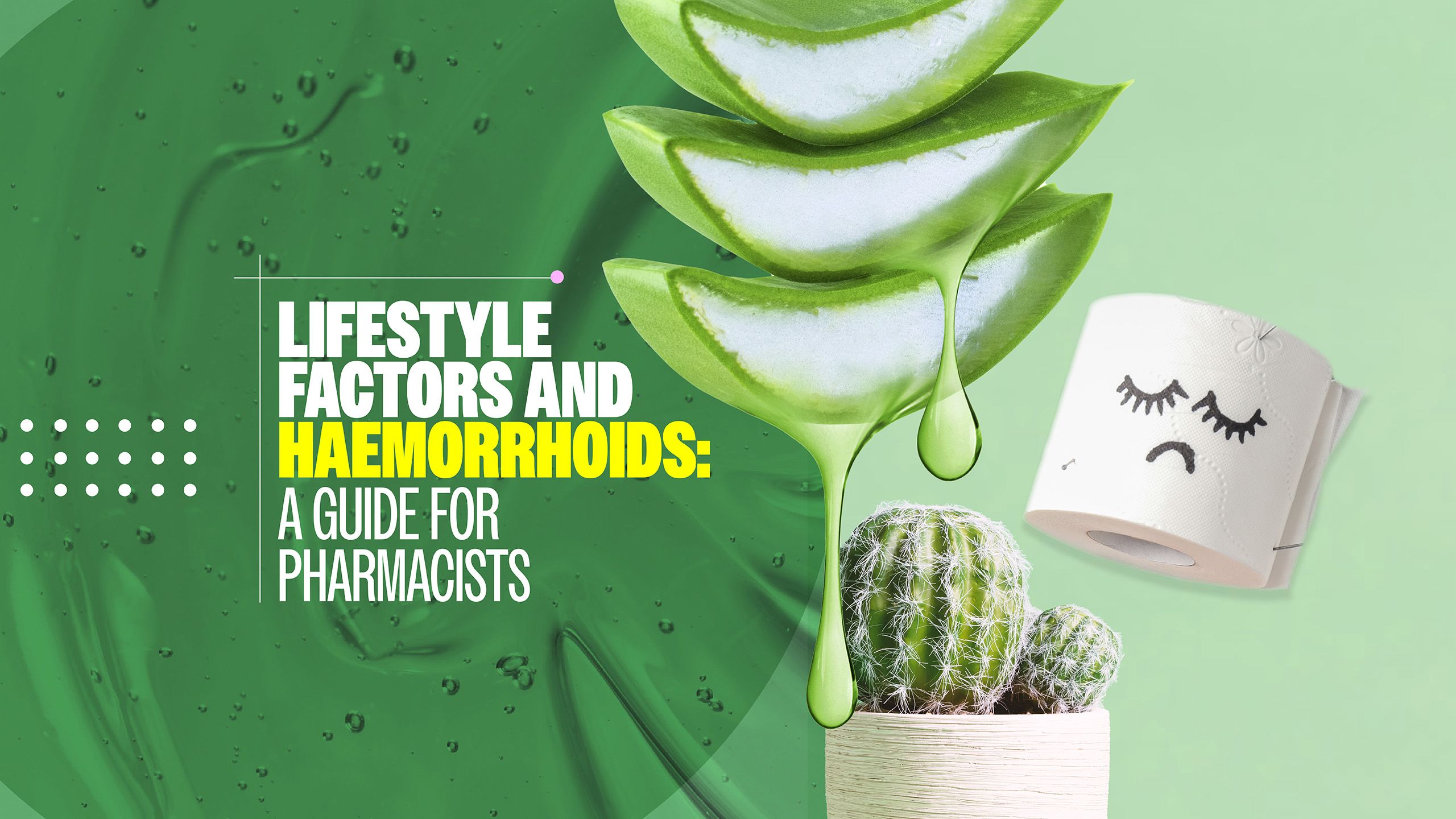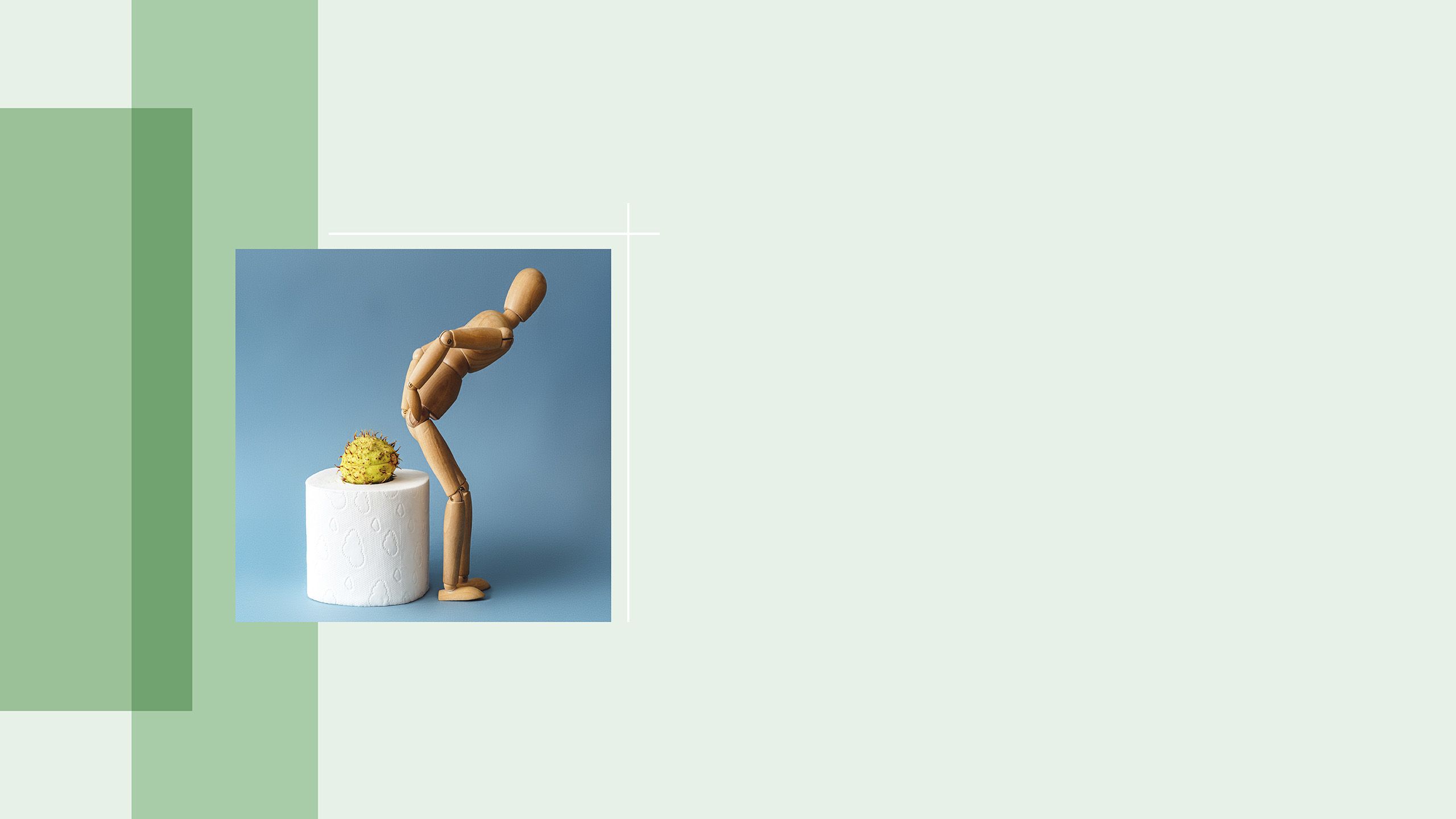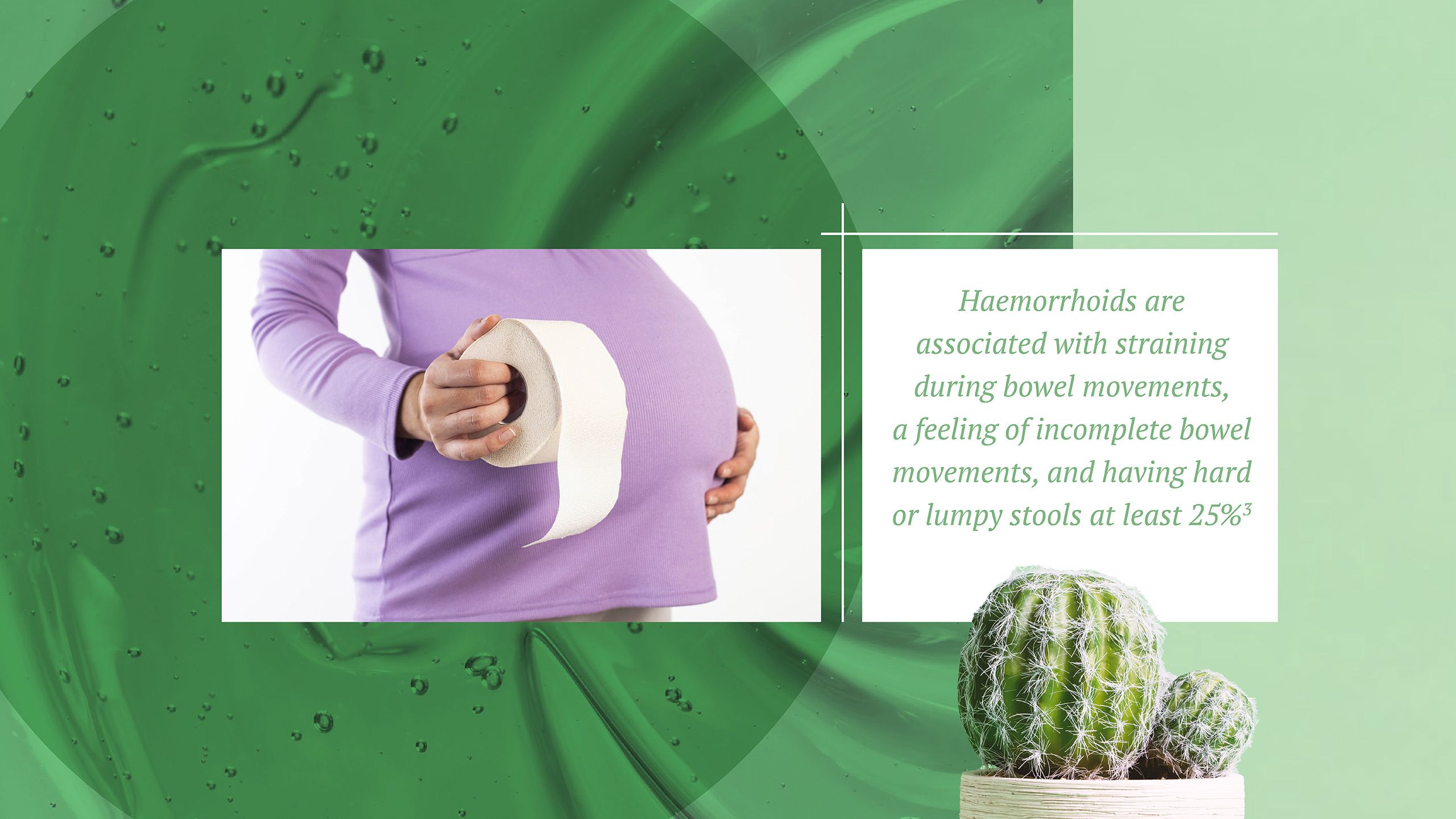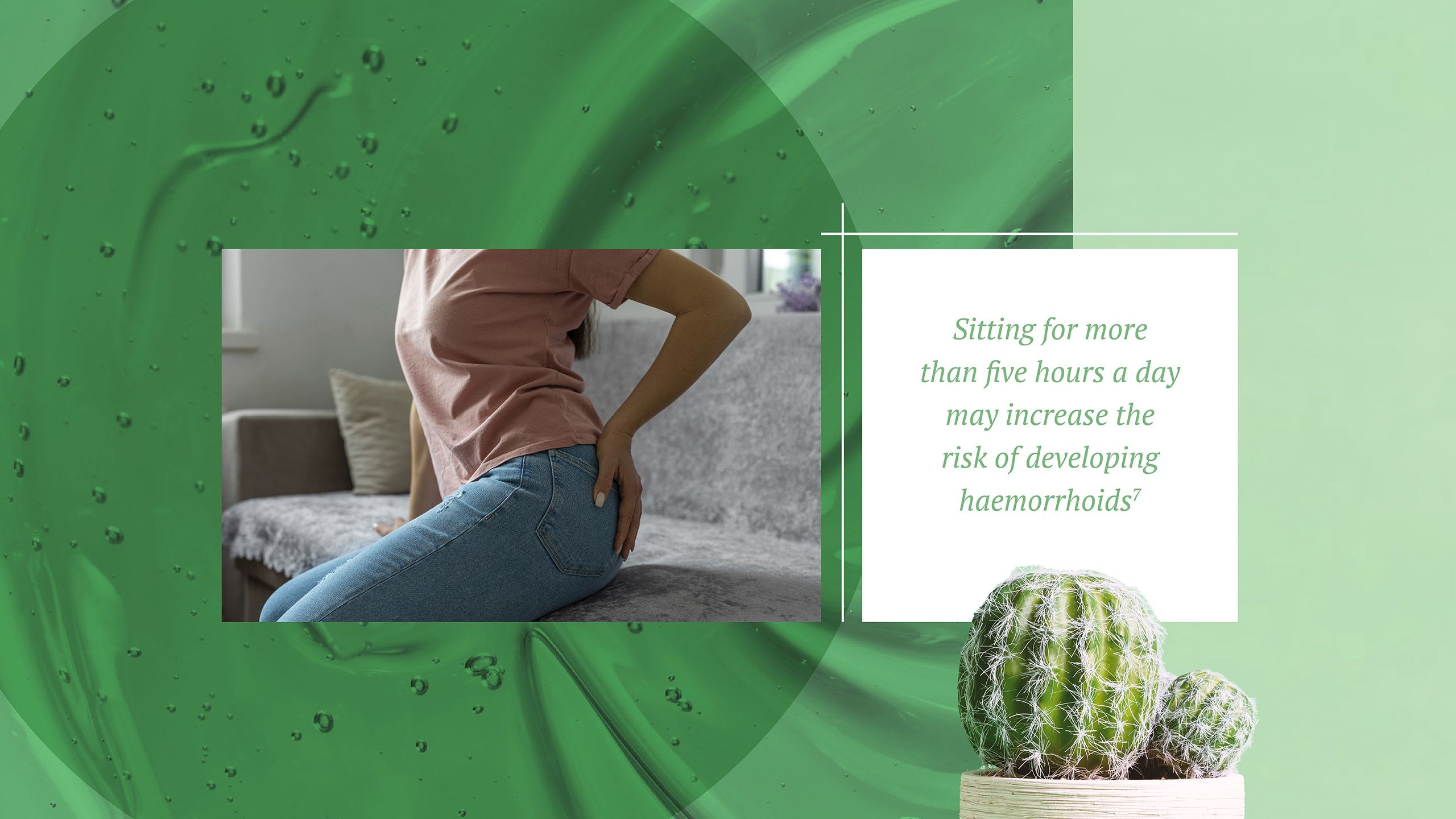
Haemorrhoids, also referred to as piles, represent a common anorectal condition characterised by swollen and inflamed veins in the rectum or anus1. Pharmacists can play an important role in haemorrhoid management by improving patient education, promoting safe self-care, and ensuring timely referral for medical intervention when necessary2 Simple lifestyle changes can greatly reduce the recurrence and frequency of haemorrhoids2.


LIFESTYLE FACTORS CONTRIBUTING TO HEMORRHOIDS
- Low fibre intake and constipation
Haemorrhoids are associated with straining during bowel movements, a feeling of incomplete bowel movements, and having hard or lumpy stools at least 25% of the time.3,4 - Dehydration
Inadequate fluid intake worsens constipation5. Without enough moisture, the body draws water from the stool to maintain hydration, leading to dry, hard stools that are more difficult to pass6. - Prolonged sitting and sedentary lifestyles
Sitting for more than five hours a day may increase the risk of developing haemorrhoids. This risk is associated with prolonged sitting in any context — whether at work (eg drivers), during study, or at leisure. Prolonged sitting increases pressure and reduced blood flow in the anal canal.7 - Obesity and elevated BMI
Increased body mass index, body fat percentage, waist circumference, and waist-to-hip ratio are linked to a higher risk of haemorrhoids8. Excess adiposity raises intra-abdominal pressure, impairing venous return and causing venous engorgement in the distal rectum8. Additionally, adiposity is associated with chronic inflammation and oxidative stress, which can damage supporting tissues through the release of oxygen radicals, inflammatory cytokines, and tissue-remodelling proteins, ultimately impairing the structure of anal cushions and promoting haemorrhoid development8. - Pregnancy
Haemorrhoids often worsen during pregnancy, particularly in the third trimester and postpartum, reducing quality of life9. The growing uterus increases abdominal pressure and compresses the rectum, inferior vena cava, and portal vein, leading to venous stasis and reduced blood flow to the internal anal sphincter. Circulating blood volume also increase by 25-40%, further contributing to vascular dilation and congestion. Hormonal changes, especially increased progesterone, relax vein walls, increasing susceptibility to swelling and the development of haemorrhoids.9 - Poor bowel habits and chronic straining
Poor bowel habits, particularly prolonged time spent on the toilet, are a stronger predictor of haemorrhoids than straining.10 This extended duration is often associated with passive smartphone use, which can lead to prolonged sitting and increased pressure on the haemorrhoidal cushions10. Chronic straining increases intra-abdominal pressure to overcome the resistance faced by the descending stool4, resulting in the persistence of prolapsed anal cushions.4 - Physical activity
Given the broad health benefits of physical activity, it should never be discouraged, however, patients should receive proper guidance on safe exercise practices11. For example, strenuous activities like heavy lifting may increase the risk of haemorrhoids and should be approached with caution.11 - Chronic conditions
Pre-existing conditions such as inflammatory bowel disease, including Crohn’s disease and ulcerative colitis12, as well as lower extremity chronic venous insufficiency13 – commonly associated with varicose veins13 – can increase a patient’s risk of developing haemorrhoids.13 These conditions contribute to increased intra-abdominal pressure, which can lead to conditions such as constipation.13 Chronic pressure exacerbates both venous insufficiency and haemorrhoid disease.13


PREVENTION AND MANAGEMENT STRATEGIES
Preventive counselling can empower patients in lifestyle-modifiable risk factors:
- Encourage high-fibre diets
• Recognising insufficient dietary fibre as a major risk factor3 allows pharmacists to highlight emphasising its role in bowel health. Good dietary sources of fibre include legumes, nuts, whole grains, bran products, fruits, and non-starchy vegetables. Among these, legumes (eg dry beans and peas), nuts, seeds, and whole grains are generally more concentrated in fibre than fruits and vegetables.14 Adequate total fibre intake is 38g/day for men and 25g/day for women aged 50 and younger. For adults over 50, the recommendation decreases to 30g/day for men and 21g/day for women.14 Supplementation with psyllium (7g/day for 6 weeks) improves stool consistency and regularity, reduced the use of laxatives in patients with haemorroids.14 - Promote adequate hydration
• A daily intake of at least 1.5-2 litres of water supports softer stools and better bowel function.15 - Encourage healthy physical activities
• Encourage regular moderate-intensity exercise – such as walking, cycling, or yoga – has been linked to improved gastrointestinal function in conditions like constipation.16 These benefits are largely due to enhanced intestinal motility, reduced systemic inflammation, and improved gut barrier integrity.16
• Educate patients on avoiding prolonged sitting7, and encourage breaks for light mobility. - Counsel on bowel habits
• Emphasise correct toilet behaviours, limit defecation time to 1-2 minutes and avoid straining where possible.17
• Encourage individuals to respond promptly to the urge to defecate, as delaying can lead to the accumulation of stool and increase the risk of straining.18 Maintaining proper anorectal function relies on intact sensory awareness and coordinated muscle activity.18 - Highlight weight management
• Managing body weight alleviates intra-abdominal pressure and contributes to reduced venous congestion.8 - Educate on pregnancy-specific interventions
• For pregnancy-related internal haemorrhoids that can present with sudden and severe pain, initial management should be conservative. Recommend adequate pain relief, oral and topical flavonoid preparations, and warm sitz baths to improve anal circulation and reduce internal sphincter tone.9 While most pregnant women respond well to these measures, surgical intervention may be necessary in cases where symptoms persist or worsen.9 - Recommend conservative treatments when needed
• For patients where lifestyle adjustments have not been successful in addressing constipation, the use of laxatives (eg docusate sodium)19 or OTC topical agents (eg gels, or wipes)20 may be recommended.
PHARMACISTS’ ROLE
Pharmacists are often the first point of contact for individuals experiencing haemorrhoid symptoms and play a critical role in early management. By using structured assessment frameworks and referral algorithms, pharmacists can systematically evaluate symptoms, identify red flag indicators requiring physician referral, and recommend appropriate OTC treatments. This frontline role not only supports accurate self-care and strengthens patient education but also ensures timely referral and intervention when necessary, improving overall patient outcomes.21
REFERENCES
- National Institutes of Health. Definition & Facts of Hemorrhoids. 2016 [Internet]. Available at: https://www.niddk.nih.gov/health-information/digestive-diseases/hemorrhoids/definition-facts.
- Koivisto CA. Hemorrhoids: A Sensitive Subject. UCONN You Asked for It Continuing Education [Internet]. December 2024. Available at: https://pharmacy.media.uconn.edu/wp-content/uploads/sites/2740/2024/12/Hemorrhoids-CE-FINAL.pdf.
- Peery AF, Sandler RS, Galanko JA, et al. Risk factors for hemorrhoids on screening colonoscopy. PLoS One [Internet]. September 2015. Available at: https://doi.org/10.1371/journal.pone.0139100.
- Margetis N. Pathophysiology of internal hemorrhoids. Ann Gastroenterol [Internet]. 2019. Available at: http://www.annalsgastro.gr/files/journals/1/earlyview/2019/ev-01-2019-19-AG4360-0355.pdf.
- Diaz S, Bittar K, Hashmi MF, et al. Constipation. In: StatPearls [Internet]. Treasure Island (FL): StatPearls Publishing; November 2023. Available from: https://www.ncbi.nlm.nih.gov/books/NBK513291/.
- Wang DC, Peng XF, Chen WX, et al. The Association of moisture intake and constipation among us adults: evidence from NHANES 2005–2010. BMC Public Health 25, 399 (2025). https://doi.org/10.1186/s12889-025-21346-x
- El Shallaly GEHA, Malik EFM, Ali MAA, et al. Is Prolonged Sitting a Risk Factor in Developing Symptomatic Hemorrhoids and Anal Fissures? Ann Digest Liver Dis. 2022; 4(1): 1018. Available at: https://www.remedypublications.com/open-access/is-prolonged-sitting-a-risk-factor-in-developing-symptomatic-hemorrhoids-8601.pdf
- Huang J, Gui Y, Qin H, et al. Causal association between adiposity and hemorrhoids: a Mendelian randomization study. Front Med (Lausanne) [Internet]. October 2023. Available at: https://pmc.ncbi.nlm.nih.gov/articles/PMC10587414/
- Bužinskienė D, Sabonytė-Balšaitienė Ž, Poškus T. Perianal diseases in pregnancy and after childbirth: frequency, risk factors, impact on women's quality of life and treatment methods. Front Surg [Internet]. February 2022. Available at: https://pmc.ncbi.nlm.nih.gov/articles/PMC8894587/
- Ramprasad C, Wu C, Chang J, et al. (2025) Smartphone use on the toilet and the risk of hemorrhoids. PLoS One 20(9): e0329983. https://doi. org/10.1371/journal.pone.0329983. Available at: https://journals.plos.org/plosone/article?id=10.1371/journal.pone.0329983
- Romano L, Giuliani A, Paniccia F, et al. Sport practice and hemorrhoidal disease: results from a self-assessment questionnaire among athletes. Int J Colorectal Dis [Internet]. January 2025. Available at: https://link.springer.com/article/10.1007/s00384-024-04797-3
- Wang H, Wang L, Zeng X, Zhang S, Huang Y, Zhang Q. Inflammatory bowel disease and risk for hemorrhoids: a Mendelian randomization analysis. Sci Rep. 2024 Jul 19;14(1):16677. doi: 10.1038/s41598-024-66940-y. PMID: 39030236; PMCID: PMC11271563. Available at: https://pubmed.ncbi.nlm.nih.gov/39030236/
- Ekici U, Kartal A, Ferhatoglu MF. Association between hemorrhoids and lower extremity chronic venous insufficiency. Cureus [Internet]. April 2019. Available from: https://pmc.ncbi.nlm.nih.gov/articles/PMC6584716/
- Higdon J. Fiber. Updated 2019. [Internet]. Available at: https://lpi.oregonstate.edu/mic/other-nutrients/fiber
- Bellini M, Tonarelli S, Barracca F, et al. Chronic constipation: is a nutritional approach reasonable? Nutrients [Internet]. September 2021. Available at: https://pmc.ncbi.nlm.nih.gov/articles/PMC8538724/
- Al-Beltagi M, Saeed NK, Bediwy AS, et al. Exploring the gut-exercise link: A systematic review of gastrointestinal disorders in physical activity. World J Gastroenterol [Internet]. June 2025. Available from: https://pmc.ncbi.nlm.nih.gov/articles/PMC12175863/
- Bhuta R. Everything You Need to Know About Hemorrhoids You May Be Surprised at What Habits Can Cause Them. 2022 [Internet]. Available at https://www.templehealth.org/about/blog/everything-you-need-to-know-about-hemorrhoids#:~:text=Hemorrhoids%20can%20be%20managed%20right,reducing%20the%20need%20to%20strain
- Andrews CN, Storr M. The pathophysiology of chronic constipation. Can J Gastroenterol [Internet]. October 2011. Available at: https://pmc.ncbi.nlm.nih.gov/articles/PMC3206564/
- Hannoodee S, Patel P, Annamaraju P. Docusate. In: StatPearls [Internet]. Treasure Island (FL): StatPearls Publishing; August 2023. Available at: https://www.ncbi.nlm.nih.gov/books/NBK555942/
- Klein E, Shapiro R, Ben-Dahan J, Simcha M, Azuri Y, Rosen A. A prospective, randomized, three-arm, open-label study comparing the safety and efficacy of PP110, a novel treatment for hemorrhoids, to Preparation-H® Maximum Strength Cream in the treatment of grade 2-3 hemorrhoids. Mol Cell Ther. 2015 Jul 3;3:6. Available from: https://pmc.ncbi.nlm.nih.gov/articles/PMC4506449/
- Nakhla N, Hospattankar A, Siddiqui K, et al. Improving Hemorrhoid Outcomes: A Narrative Review and Best Practices Guide for Pharmacists. Pharmacy, 2025, 13, 105. https://doi.org/10.3390/ pharmacy13040105. Available from: https://www.mdpi.com/2226-4787/13/4/105
Image Credit: Getty Images



